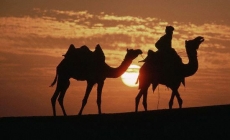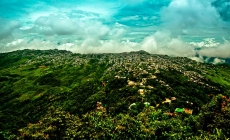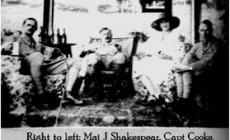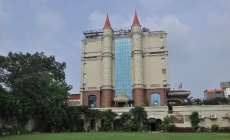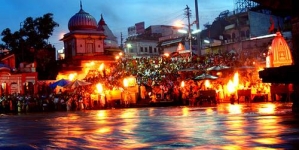-
Rajasthan - November 4, 2015
-
Haryana History - November 1, 2015
-
Haryana - November 1, 2015
-
Mizoram Minerals - March 3, 2015
-
Mizoram Hotels - March 2, 2015
-
Mizoram Culture - March 2, 2015
-
Mizoram Tourist Places - March 2, 2015
-
Mizoram History - March 1, 2015
-
Chhattisgarh Minerals - February 27, 2015
-
Chhattisgarh Hotels - February 27, 2015
Languages spoken: Hindi, Urdu, Awadhi, Braj, Bhojpuri and English
Uttar Pradesh is a microcosm of the entire Indian nation in its diversity. Multi ethnic, multi religious and multi cultural, Uttar Pradesh has absorbed many an immigrant culture and race within its borders and created a unique cultural heritage found nowhere else in the country. Its people belong to many religions and come from distant parts of the country but have had the latitude to recreate their own native cultures. Afghans, Kashmiris, Bengalis, Parsis and Punjabi immigrants settled here. Christians, Hindus, Muslims and Buddhists all found the freedom to practise their religions and pass it on to successive generations.
One of the least developed states in the country; it has some highly industrialised pockets. While it is secular, liberal and progressive, at the same time it is deeply rooted in social and religious traditions and taboos. While its diversity is its strength, it is often equally divisive although rarely parochial. Inherently secular in character, it is also the place where religious buildings are torn down by rampaging fundamentalists.
Religion
The majority of the people are Hindus while a large percentage of the minority practice Islam. There are also a fair number of Christians in Uttar Pradesh.
Food
The cuisine of Uttar Pradesh is just as diverse as its geography. Ranging from simple every day fare to rich, elaborate banquets, the cuisine of Uttar Pradesh has absorbed and adapted a variety of cuisines to create an entire feast of wonderful dishes. Many of the Hindu communities are staunch vegetarians and they have created a vast variety of vegetarian dishes ranging from the all time favourite ‘puri-aloo’ or potatoes and fried wheat bread to savouries and divine desserts and sweetmeats. The Muslims, Kashmiris, Kayasthas and Christian communities cook up a storm of non-vegetarian dishes including a delectable selection of breads, kababs, curries and biryanis. The Muslim cuisine, of northern Uttar Pradesh is very different from the Mughlai food of Delhi. The Nawabs of Oudh were great gourmets and encouraged their master chefs to create new styles of cooking like the famous ‘Dum Pukht’ of Lucknow where the food is sealed in large pots called ‘Handis’, placed over a slow fire and left to cook in its own juices. When opened, these dishes release the most fragrant and delicious aromas. Lucknow and its neighbouring towns were put on the culinary map of India thanks to these rich curries, melt in the mouth kababs, fragrant rice biryanis and pulaos and an eclectic variety of leavened and unleavened breads.
Culture
Uttar Pradesh has been the cultural seat of the country for a very long time. The history of Uttar Pradesh is fascinating, and it has shaped a rich cultural heritage of the state that has emerged as the focal point of the Indian culture. The Mauryans, the Mughals, the British, etc. all brought with them their own cultural traits.
A cultured, genteel lifestyle was the essence of the rule of the Muslim Nawabs of Awadh. Music, dance, literature, poetry, arts and crafts flourished under royal patronage. Women were encouraged to learn the fine arts and to read and write, albeit within the ‘purdah’. Litterateurs, painters, dancers and musicians created masterpieces in their respective genres.
Writers like Munshi Premchand, Mahadevi Verma, Srikant Verma, poets like Suryakant Tripathi ‘Nirala’, Harivanshrai Bacchan, Sumitra Nandan Pant, Mahavir Prasad Dwiwedi, and Upendranath ‘Ashk’; artistes of the stature of the shehnai maestro Ustad Bismillah Khan, Kathak wizard Birju Maharaj, tabla maestro Kishan Maharaj, the legendary Baba Allaudin Khan and his disciples Pt. Ravi Shankar and Ustad Vilayat Khan; ghazal singers Begum Akhtar, Rasoolan Bai, Girija Devi and many more have lived and practised their art and craft here.
Uttar Pradesh is the place where one of the six foremost classical dances of India, the Kathak, flourished. The word Katha, from which the name is derived, means story. It originated in northern India, during the 7th century A.D. Kathak has very intricate and complex movements of hands and feet along with facial expressions. The footwork is accompanied by the music of various percussion instruments such as tabla and pakhwaj, which are native to north India.
Folk arts of Uttar Pradesh include these theatrical forms-
Braj Raslila, which is associated with the life of the lover-God, Lord Krishna
Ramlila is another such art form dealing with the life of Lord Rama
Charukala is another folk dance of the state. The dance of Charkula involves a female dancer balancing a column of lighted deepikas over her head while dancing.
Rasiya describes the love of Radha and Shri Krishna. Charkula and Rasiya are native arts of the Braj region of the state.
Crafts
One of the important crafts of Uttar Pradesh is Chikankari, which entails delicate and traditional hand embroidery. This form of handicrafts is mainly practiced in Lucknow. It is done on fabrics like chiffon, doruya, muslin, organza, organdie and silk. Chikan saris and Kurtas make the perfect summer wear.
Zardoji embroidery is another unique art where the embroidery is done in three dimensions. Zari works of Benaras are famous the world over.
Pottery and exquisite metal ware products are also created on a large scale in Uttar Pradesh.
Carpet weaving is also an important cultural expression of Uttar Pradesh. The state caters to 90 percent of the country’s carpets and the carpet weaving centers in the state are primarily located around Mirzapur, Khamaria and Bhadohi.
Metal Ware
Brassware Uttar Pradesh is the largest Brass and Copper producing state in India. In domestic-ware each of the ‘lotas’ (small water-pots) is known by the name of its origin, like Etawah, Banaras, Sitapur, etc. The ritual articles are largely in copper. Moradabad in U P is famous for art metalwork and known for it’s coloured enamelling and intricate engravings.
Pottery
Glazed pottery with white background and blue and green patterns is developed in Khurja, Chunar and Rampur in Uttar Pradesh. UP produces some of the finest Chunar black clay pottery. This is inlaid with silver paint in intricate designs. The art that is perfected in Nizamabad, has high gloss and lustre derived from a powder called kabiz made from the mud of rice fields. Khurja is also well known for its cheap and tough tableware.
Terracotta
Gorakhpur has villages where clay figures of animals are done and is is famous for its ornately decorated terracotta horse. The potter creates the basic form by throwing separate pieces on the wheel and then joining them.
Jewellery
Lucknow is well known for its jewellery and enamelling work. Exquisite silverware’s with patterns of hunting scenes, snakes and roses are very popular. The Bidri and Zarbuland silver works of Lucknow find expression on excellent pieces of huqqa farshi, jewel boxes, trays, bowls, cufflinks, cigarette holders, etc. Renowned ivory and bone carvings with motifs of flowers, leaves, creepers, trees, birds and animals are widely produced in Lucknow. The master craftsmen create intricate items like knives, lampshades, shirt pins and small toys.
Perfume
‘Attars’ or perfumes are also produced in Lucknow from the 19th century. The Lucknow perfumers experimented and succeeded in making attar with delicate and lasting fragrances those are made from various aromatic herbs, spices, sandal oil, musk, essence of flowers, and leaves. The famous Lucknow fragrances are khus, keora, chameli, zafran and agar.
Painting
The tradition of painting in Uttar Pradesh goes back to pre-historic times. The cave paintings of Sonbhadra and Chitrakoot depict scenes of hunting, war, festivals, dances, romantic life and animals. The golden period of Painting in UP was the Mughal Era. The art of painting attained its peak during the reign of Jahangir. The Mughal style of painting remains one of the greatest achievements of Asian culture and is unique in its concept, presentation and style.
The art of painting reached the epitome of perfection in the area of Bundelkhand when the King of Orchha reconstructed the temple of Keshav Dev in Mathura. The paintings of Mathura, Gokul, Vrindavan and Govardhan depict scenes from the life of Lord Krishna.
Another major pre-modern painting tradition of UP is known as the Garhwal School which was patronized by the Kings of Garhwal.
Music
Uttar Pradesh was the land of the great sages and hermits and the singing of ancient hymns and mantras laid the basic tradition of music, which has blossomed into a musical tradition. The medieval age saw the emergence of two distinct strands of music. One was the court music that found patronage in the Courts like Agra, Fatehpur-Sikri, Lucknow, Jaunpur, Varanasi, Ayodhya, Banda and Datiya. The second was the religious tradition emerging from the Bhakti Cult rooted and flowered in centres like Mathura, Vrindavan and Ayodhya. Rulers and musicians from Uttar Pradesh contributed to the prosperity of Hindustani music.
Cultural heritage
Some scholars are of the view that the Rig Veda was composed in the Gangetic valley. But even if this be not true, it is generally accepted that a substantial portion of the Vedic literature had its origin here in its many hermitages, which were seats of learning. Some of the big names in Hindu sacred literature, such as Yajnavalkya, Vashishtha, Vishwamitra, Valmiki, Attriyea, Bharadwaja, Kapil and Vyas lived in these sylvan retreats of Uttar Pradesh and inspired millions through the ages. Uttar Pradesh’s greatest gifts to humanity are the two epics, ‘Ramayana’ and ‘Mahabharata’. From the epic age, the territory of Uttar Pradesh being watered by several fresh streams of culture, the two most significant being those generated by the teachings of the Buddha and Mahavira, the 24th Jain Tirthankar.
Brahmanical culture eclipsed by the more virile and vigorous Buddhism. Culture in all its manifestations served the ends of religion. The fountainheads of Brahmanical culture were centered at holy places as Kashi, Ayodhya, Prayag, Mathura and the Himalayan hermitages. Mathura has proved to be a veritable store-house of buried ancient art, both of the Brahmanical and Buddhist varieties and Kashi, which has withstood the ravages of times, of living Hindu art.
Festivals
The important Hindu festivals of Uttar Pradesh are Navaratri, Diwali, Shivaratri, Raksha Bandhan and Janmashtami
Karva Chauth: This festival of fasting and feasting falls on nine days after Dussehra, on the fourth day of the Karva Chauthdark fortnight of Kartika. Karva Chauth is held by married Hindu woman for the safety and prosperity of their husbands.
Annakoot is celebrated which is devoted to feasting and Govardhan Puja in the evening and rounded up next day by Bhaiya Dooj when sisters apply vermilion tika (auspicious mark) on the forehead of their brothers who reward them with money.
Shitla Ashtami, which falls on eighth day after Holi, is devoted to the goddess of small-pox, followed by Ram Navami on Chaitra Sudi Navami, commemorating the birth of Lord Rama; Baisakhi Purnima, a big bathing day; Bargadee Amavasya in Jaistha Dussehra, another great bathing day; Guru Purnima in Asadh when Vyas Puja is held and Nag Panchami dedicated to the worship of the Snake God, Shesha.
Janmashtami is the most important Hindu festival celebrating the birthday of Lord Krishna. This festival is followed by Hartalika Teej, Ganesh Chaturthi, Anant Chaturdashi, and Pitra Visarjan Amavasya devoted to making of oblations to the Pitras (dead ancestors) and is called Pitra Paksha. Bharat Milap which is celebrated during the month of October or November is performed at Nati Imli on the day following Vijayadashmi (Dusshera). It pertains to the episode of the return of Lord Rama to Ayodhya after 14 years of exile, and his reunion with his brother Bharat.
Muslim Festivals
The most solemn and colourful Muslim function held in the state is Muharram, commemorating the martyrdom of Imam Hussain, the grandson of the Holi Prophet. In all cities and towns Muslims take out impressive processions of colourfully decorated tazias, replicas of the martyr’s tomb at Karbala. The most solemn and impressive Muharram is observed in Lucknow, where gold and silver replicas of old Nawabi times are brought out and men beat their breasts in mourning constantly until blood oozes out. The two Imambaras and Shah Najaf are beautifully illuminated for two days. An impressive event is a fire-walking feat held in one of the Imambaras. After the burial of the tazias on the tenth day, a gathering of mourners in utter darkness is held, known as Majlis Sham-i-Ghariban, one of the most soul-stirring events among Muharram observances. The other occasions of religious importance for Muslims are Id-Ul-Fitr, Ramzan (a month devoted to fasting), Chehlum, Bara Wafat, Shah-i-Barat and Id-Uz-Zuha.
References:
http://www.up-tourism.com/People_language_culture.htm


